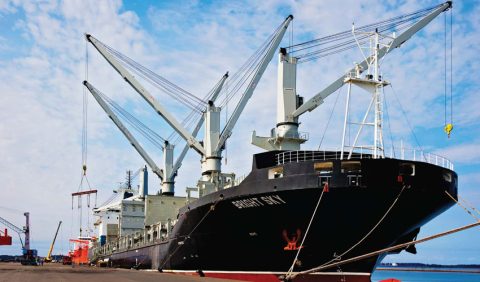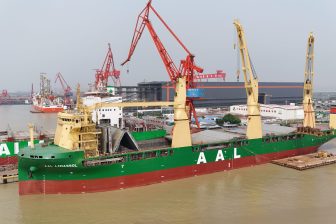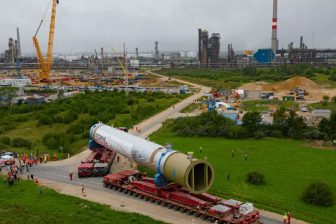
SEDNA: multipurpose sector outlook positive, digitalisation to play a vital role
Two major trends are anticipated to fuel growth in the breakbulk sector in 2023, the first being the focus on decarbonisation and the second being the shortage in the construction equipment market, driving the prices up. Commenting on the state of the sector, SEDNA’s VP of Strategic Accounts, Cynthia Worley, notes that these trends are likely to create significant demand for breakbulk and project cargo services.
The push for renewables and the decarbonisation of global energy will be the biggest driver for the breakbulk and project fleet. While fossil fuels will continue to dominate energy generation, a concurrent pursuit of sustainability, decarbonisation, and greener alternatives is gaining momentum influencing project logistics – and pandemic-delayed energy projects are returning to life. You can’t rely on containers to carry big modules (like wind turbine blades), so the multipurpose fleet will see a boost, Worley said.
Vulnerabilities exposed
Initially, the pandemic exposed the vulnerabilities of the global supply chain, particularly impacting project shippers who work through an on-demand approach, suddenly finding themselves struggling to secure the space and sailings needed in 2021 and 2022.
But the crisis also demonstrated the sector’s immense flexibility. Widespread supply chain disruptions created a “spillover” market, where large volumes of formerly containerised cargo was pushed towards non-containerised shipping segments. The multipurpose sector swiftly adapted to capitalise on this spillover throughout 2021, and continued to benefit from it for much of 2022. After a decade or more of recession in the multipurpose sector, this was a welcome tailwind, Worley adds.
While the trend has peaked, with container rates softening, it remains to be seen whether we will witness a complete return to the pre-pandemic status quo or if this spillover will continue. Cargo owners may still view alternatives to container shipping as a pressure-relief valve and a long-term risk management strategy, particularly in the face of ongoing geopolitical and macroeconomic uncertainty.
Ageing fleets may also be a notable concern, with reduced new ship construction taking place across the sector. At the same time, increased competition from the container shipping industry will impact the breakbulk market. As Susan Oatway, Research Analyst of Project and Breakbulk Cargo at the Journal of Commerce, pointed out, there is a massive order book for container ships, due to the significant profits accumulated by these companies in recent years. These vessels will start to enter service by the end of the year.
Thus, while the heavy-lift capable fleet may see growth, the remainder of the multipurpose sector may be impacted by a weakening global economy, as predicted by Drewry.
What does the future hold for the MPP sector?
As Worley noted, the outlook for the sector is incredibly promising, with the dual focus on decarbonisation being one of the demand drivers, resulting in more investment in renewables, and a renewed commitment to energy security. Additionally, as stated already, construction equipment market supply shortages mean higher prices.
At the same time, the Russian invasion of Ukraine has raised fresh concern over energy (and food) security. Issues of source diversification and self-sufficiency are now intertwined with the accelerating shift toward decarbonisation. Economic sanctions and countries wishing to diversify their dependance on single country suppliers of oil, gas and other commodities will enable markets to reduce vulnerabilities to supply shocks.
These dual threads of continued investment in renewable energy projects and the desire to diversify supply and/or become self-sufficient will be a boon for both breakbulk and project cargo throughout 2023.
Nonetheless, to thrive in 2023’s ever-changing political and economic climate, project and breakbulk shippers, as well as logistics service providers, will need a sophisticated understanding of regulatory requirements and business-related risks. And new emissions regulations from the International Maritime Organisation and the European Union, along with recommendations from governments, investors, cargo owners, and other stakeholders will also impact the multipurpose shipping sector.
The impact of digitalisation
Amid uncertainty and new challenges, collaboration and efficient communication in the sector have become more critical than ever. Digitalisation will play a vital role in 2023 and beyond.
Embracing digital technologies – from enhancing email management to automated tracking and scheduling systems, and artificial intelligence – diminishes the reliance on physically exchanging paperwork and manual processes for the breakbulk and project cargo sector. This will expedite and refine cargo movement, reduce the risk of delays, errors and losses while cutting costs and streamlining the supply chain.
And with bandwidth increasing on ships, it could also enable more business applications to be deployed onboard. This may not only enhance ship-to-shore collaboration, eventually advancing towards real-time communication, but it could also enable faster responses to regulatory and insurance requirements.
In short, digitalisation promises to make the intricate supply chains of breakbulk and project cargo leaner and more agile, enhancing the competitiveness of the multipurpose sector at a time when it faces an aging fleet and increasing pressure from the container sector.
Whatever the future brings, we look forward to discussing the trajectory of breakbulk and project cargo this year and beyond, and examining how digitalisation will support the multipurpose sector’s competitiveness.
You just read one of our premium articles free of charge
Register now to keep reading premium articles.




